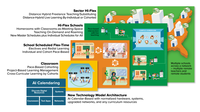This is something school districts have talked about for years. They have dreamed about it. They have danced around it. They have spent billions to warehouse it. They have pulled their hair our worrying about it. They have worked their teachers to tears, to exhaustion, and often to quitting to try to organize and control it. They have stockpiled untold quantities of it. They can’t live with it, and they certainly can’t live without it. They can’t get a moment’s piece because of it. And if there was a company that could simply handle it for them, then that company would be opening a new world for them.
Of course, we’re talking about data.
If only I had a nickel for every time I heard a superintendent say, “If I could just get my hands around it, there is no limit to what I could do for my learners.” Well, I’d have a huge stack of nickels.
Getting your hands around your data is much more complicated than simply using a dashboard to string together various siloed data sources. A more modern approach must include:
- Centralization of all your data sources in one place, accessible by all stakeholders
- Visualization of your data in meaningful ways to answer the questions your stakeholders have about student success
- Synthesization of your data to bring together multiple data points from different areas to paint a complete picture of student success
- Data intelligence to determine causation and correlation, as well as make predictions that can help you take proactive measures
Of course, you need a dashboard, although it is long past time to redefine the meaning of that term. You’ll also need someone with the ability to access every bit of information (when and how it is needed), delivered to you exactly when you need it (in a highly actionable state) – and also delivered to every member of your team, from assistant superintendents through to district and school level managers, and to the fingertips of every educator precisely when he or she needs it. This is true for the information you know you need, as well as the information you may not even realize you need. What we are talking about is a service that can give you command of all available information.
The goal is not to limit your information. You’ll want to determine all the different sources from which to pull data and centralize it. You’ll then triangulate the data to gain genuine insights on your learners. Leveraging these additional sources will allow you to ask deeper questions and identify proactive measures.
Say no to cybercrime
Perhaps one of the biggest reasons to have an outside firm handle all your district’s data is security. The education industry has become the number one target of data criminals. Locking out, ransoming and/or stealing data from K-12 school systems has become Job One for the upwardly mobile career cybercriminal.
Having a company or organization take care of your district’s data would, by definition, include securing your district’s data. Last year, 56 percent of K-12 schools worldwide reported being hit by a ransomware attack, according to a Sophos study. Almost all the education organizations that were attacked and had their data encrypted got some of the data back, but not all. On average, K-12 education organizations that paid the ransom only got back 61 percent of their encrypted data. The overall cost to clean up the ransomware attacks last year was an earthshaking $1.58M per incident. That’s a lot of money, especially for small districts with only a few schools. And the psychological damage goes much higher, for the reputation of the district and for the individual responsible for clicking on that suspicious link. With an outside company overseeing all your data, security becomes their responsibility, and no longer your headache.
Until recently, this Data-as-a-Service for education wasn’t technologically feasible. Now, it is not only feasible, but it may be unwise to do it any other way.
Go boldly, confidently
If I were going to sum up the top reason to employ Data-as-a-Service in your district, I would have to say confidence. Confidence to know your data is safe and protected. Confidence to know that every stakeholder in your organization has access to the information they need when they need it. And confidence to know you have the information you need to ensure every learner is getting the best possible education on every level.
Most districts are literally drowning in data, but at the same time, their students are dying of thirst. There is far too much data to be able to find and use what you need when you need it. Educators are the heart and soul of the district. Even most management positions, from the school-based principal to the district superintendent, came up through the ranks. It doesn’t make sense for these folks to have to be data experts as well as learning experts.
Once all the collected data makes it to your fingertips as well as your educators’ fingertips, then everyone in the learning community can see the whole picture. There will be an actionable view of data for teachers, administrators, counselors, parents, family members and every other stakeholder. This enables real access to necessary information, and the student becomes the center of everything.
About the author
Zach Vander Veen has worn many hats in education, including history teacher, technology coach, administrator, and director of technology. He loves learning, teaching, traveling and seeking adventures with his family. Currently, Zach is the co-founder and Senior Vice President of Innovation and Outcomes at Abre, an education management platform.











